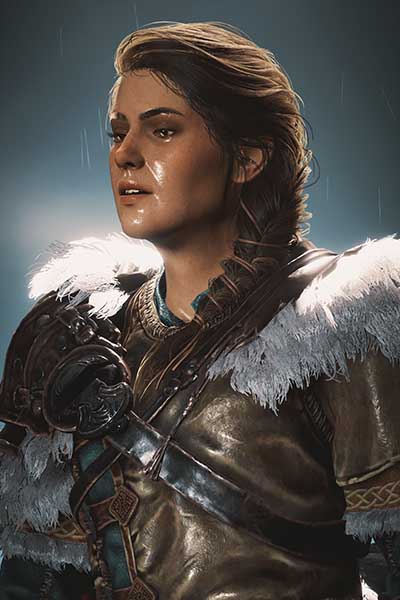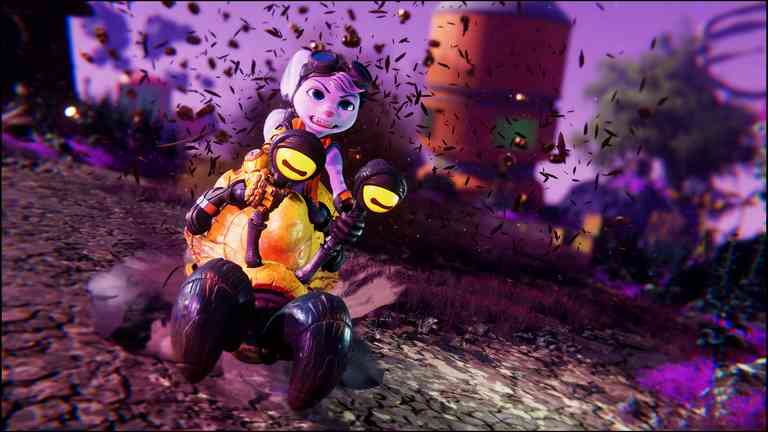Transformative gaming practices: what can
we learn from them?
On the 2nd of September 2021, Lakeside Arts Nottingham hosted a live stream session with Colin Nguyen, Lem Fillyaw and I as a result of the exhibition ‘Press Start: An exploration of creative gaming culture’ (31 July – 5 September 2021). After a brief introduction given by Neil Walker, Head of Visual Arts Programming at Lakeside Arts, I provided an overview of the three creative practices explored in the project ‘Press Start: The use of videogame assets in audience creative practices’ and the exhibition itself: machinima, in-game photography and gamics. Colin and Lem joined the conversation after this point, talking about their experiences with in-game photography and how they have benefited from its practice.

For Colin, the practice of in-game photography (IGP) made possible to engage with two of her biggest passions, the exploration of historical and fantasy settings and traveling, allowing her to record personal experiences without the need of investing in expensive equipment, transport, and accommodation. Motivated by improving her performance of the practice, she enhanced her knowledge in coding to create mods, and learned photography basics to eventually master her competency and ability to create the artistic and experimental shots she takes today. Moreover, Colin embarked on a journey to confront the way woman are represented in videogames, employing IGP for social and cultural change. Her shots often portray strong female characters deepening in their emotional layers and capturing traits of their personality, questioning the traditional role and representation of women as objects of desire, love interest and unidimensional narrative resources. As she explains, ‘I try to capture their vulnerabilities, complexities, and even dorkiness as a character, because it is still rare to see lead female characters in video games who are not sexualized’ (Nguyen, personal interview, 2021). Born and raised in Vietnam, Colin first got in touch with videogames before she was able to speak properly. In a blog posts, Colin explains how the influence of strong female figures in her family and the history of the country (the military leaders Lady Triệu and the Trưng sisters) shaped her idea of women and how this contrasted to the way they were represented in videogames. The lack of female lead options also influenced her lack of engagement with the medium. Until she found Kassandra, the female lead protagonist of Assassin’s Creed Odyssey (2018), developed by Ubisoft Quebec and Ubisoft Quebec, who became a source of inspiration in many ways. As she explains, ‘I had never considered video games to be a medium of expression […] NO CHARACTER until Kassandra had inspired and pushed me to learn the boring shit that I would normally won’t touch because I want do something creative’ (Nguyen NDa, original emphasis). Moved by her interest for Kassandra, Colin engaged with IGP and learned photography skills, professional software such as Lightroom and Photoshop, the basics of hexadecimals to create mods and data mining. But this is only a part of what she achieved moved by her passion for this character and the practice of IGP, she also developed her creative self and championed for a positive and non-sexualised representation of women in videogames.


Control © Remedy Games.

Hellblade: Senua's Sacrifice © Microsoft Corporation.

Assassin's Creed Odyssey © 2018 Ubisoft Entertainment. All Rights Reserved.
Additionally, the story behind how Kassandra came to be reinforces Colin’s argument. According to a Bloomberg report, the original plans to give more presence to female protagonists in Ubisoft games were dismissed by the marketing department and its chief creative officer, Serge Hascoët, because women would not sell games. Kassandra was originally the one and only protagonist of Odyssey, until it was decided to introduce a male option. However, the list does not stop here:
This was also supposedly the case with both Assassin’s Creed Syndicate, in which protagonist Evie was meant to have equal time with her brother Jacob but instead received significantly less. And an early outline of Assassin’s Creed Origins saw the protagonist Bayek injured or dead early on and his wife, Aya, playable for the remainder of the story (Valentine 2020).
The news hit the headlines in 2020, when it was made public that Ubisoft as well as other companies were facing multiple allegations for physical, emotional and sexual abuse and harassment (Taylor 2020). In a later statement, Ubisoft declared that: ‘We want to start by apologizing to everyone affected by this – we are truly sorry. We are dedicated to creating an inclusive and safe environment for our teams, players, and communities. It is clear we have fallen short of this in the past. We must do better’ (Ubisoft 2020). Fortunately, female playable characters have become more common in the last decade and their role as the protagonists at the centre of the story are now more popular than ever before in AAA games. As Colin explains in another blog post, female protagonists have not impacted negatively sales and critics, on the contrary, videogames such as The Last of Us Part II (2020), Horizon: Zero Dawn (2017), and Hellblade: Senua’s Sacrifice (2017), to give some examples, have been both a commercial success and critically acclaimed. Similarly, research on videogame audiences also challenges old beliefs, as it is no longer true that the vast majority of videogame players are males. According to the ISFE report published in 2021, 47% of all European video game players are women. This number increases to 53% when considering mobile/tablet-based games. Interestingly, videogame publishers have been very reluctant to develop games and franchises revolving around female lead characters until the last few years. Hence, it is about time to debunk the industry assumption that either male or female gamers would not be interested in or feel comfortable with playing titles in which lead character are women. It is, therefore, not a coincidence that Colin’s artwork of Kassandra is the image of the exhibition, the book and the project in general1.
Colin’s experience illustrates the importance of diversity and non-stereotypical representation in media and entertainment, but also how transformative gaming practices have the potential to inspire a growing number of people to be creative and learn soft and hard skills (such as media literacy, programming and problem solving) and subject/theme-related knowledge (e.g. history, geography, language or literature). In this vein, the potential of machinima, IGP and gamics, as a tool to motivate and teach students certain skills has also been acknowledged by visitors of the Press Start exhibition, with some teaching professionals considering their application in the education settings. Some examples are below:
‘Hopefully, I will be able to bring some of my students to inspire some outcomes of their own too. Thanks’ (Dave #7).
‘[I have gained] ideas for ways to engage my son with art through gaming’ (Clare #25).
‘What I have gained: an idea for teaching – I have a contribution to a module on digital storytelling which this feels useful for’ (Anna #27).
Unsurprisingly, it has been widely recognised the growing need for everyone, but particularly children and young adults, to learn digital creative skills for their future employment and social inclusion (UNESCO 2018; Bakhshi, Djumalieva and Easton 2019; Joris and Livingstone 2020), there is an ongoing debate on how to apply it to a policy and education level (Lucas 2020) and a increasing concern on methods to overcome lack of access and support (Jenkins et al. 2006). Videogames are a powerful narrative and immersive medium and can be used to entice others to learn through them. Research at the National Literacy Trust has found that videogames can:
· Give young people a route into reading and writing.
· Improve confidence in young people’s reading skills.
· Immerse young people in stories.
· Support positive communication with family and friends.
· Increase empathy and support wellbeing.
· Engage boys and reluctant readers with literacy.
Both adults and children can benefit in multiple ways from engaging with transformative gaming practice, which can help to fulfil personal, emotional, professional, educational needs (see Blázquez 2021). This engagement is better promoted and sustained within a welcoming environment, such as a friendly community of practitioners. In the case of IGP, this is one of the aspects in which Lem Fillyaw has contributed the most.

Fortnite © Epic Games.

Fortnite © Epic Games.

Horizon Zero Dawn © With thanks to Sony Interactive Entertainment Europe Limited.

Ratchet & Clank: Rift Apart © With thanks to Sony Interactive Entertainment Europe Limited.
As a professional event photographer in real life, Lem always loved to tell other people’s stories through his lens. However, IGP enabled him to take his creativity to a different level: ‘I could go from adventuring in deserts and jungles on earth to icy plains or undersea on an alien planet’. Lem shares his expertise and passion with others, operating as a knowledge facilitator, motivator and community host. Similar to Colin, Lem has also found in IGP a driver to embark in a social cause, supporting, inspiring and helping others to be creative with videogames and achieve their full potential in the practice. As he explains:
[m]y role is to support others. Not just by retweeting or shoutouts. No, I am supposed to be a friend, counsellor, confidante, to those in this community. I may not have been given all the talent, but I’ve got heart.
Lem self-imposed role in the IGP community led him to found The Gametographers, a small and welcoming group of practitioners (https://pwllem.smugmug.com/), in which he found a second family: ‘[s]ome of my favorite humans and best friends, even my mentor has come out of this adventure. People have become part of my family because of this. Virtual Photography has become more than a hobby’. Community members help and motivate each other, share knowledge and tips to develop further the skills and get to know other members at a more personal level, facilitating the creation of strong bonds between individuals and the group as well as building a harmonious and flexible social structure. Lem also manages the community Twitch account (https://www.twitch.tv/thegametographers/), which hosts several live streams a week featuring a mix of family-friendly social activities promoting IGP as well as discussions ‘on games and life and how they intertwine’. Additionally, he runs a gaming ministry called ‘God, Games and Geekery’ for a non-profit which includes streaming, social media, and a monthly podcast (https://godgamesgeekery.buzzsprout.com/). Lem’s history of positive encouragement and community building can be used as an example of informal approaches to create welcoming and inclusive online environments to learn and enhance digital creative skills.
There are also a few things that the videogame industry can learn from their engagement in transformative gaming practices. Supporting the performance of these practices have a series of benefits for the videogame industry such as the expansion of the lifespan of some titles, the increase in sales and the reduction of costs. For example, facilitating mod creation may encourage the establishment of long-lasting communities around certain games and gamers’ artworks may serve as unofficial promotional material circulating on the Internet. Additionally, transformative gaming practices can promote the acquisition of game passes, pre-purchases and ‘Day 1’ releases (with generally higher prices), which allows videogame publishers to start recovering their investment through these selling windows from early stages. This is particularly visible in the case of IGP, as the community of practice is generally very keen on posting images on new and trendy games as soon as they become available. Many IG photographers buy games when they are just released to keep up with the hype created within the community of practice. Interestingly, these images are a disadvantage for those who do not acquire and play the game early on, as they can contain spoilers. These and other reasons are valid points to support that the videogame industries can benefit from promoting transformative gaming practices.
1 Thanks to Ubisoft Entertainment.
